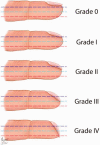Long-term outcomes of homodigital neurovascular island flap reconstruction of fingertip injuries in children
- PMID: 35786078
- PMCID: PMC9459358
- DOI: 10.1177/17531934221108470
Long-term outcomes of homodigital neurovascular island flap reconstruction of fingertip injuries in children
Abstract
We evaluated the long-term functional and cosmetic results of homodigital neurovascular island flap (NIF) used to reconstruct extensive pulp defects with bone exposure in children. Twenty-three children (mean age 4.8 years, range 1-10 years) with fingertip injuries were reconstructed with a pedicled homodigital NIF and evaluated in terms of sensation quality, cold intolerance, scar formation, nail deformity, range of motion and overall finger length at a mean follow up of 7.8 years (range 2-13). Eleven patients reported cold sensitivity in the operated fingertip, and 15 presented with hook nail deformities at the final follow-up. The total active motion of the injured finger was significantly lower than that of the uninjured side (p < 0.001). NIFs is a safe, reliable reconstructive treatment for fingertip loss in children, but commonly encountered issues in the long term include an extension lag of the interphalangeal joints, hook nail deformities and cold intolerance. Level of evidence: IV.
Keywords: Children; fingertip defect; fingertip injuries; homodigital neuvascular island flap.
Conflict of interest statement
Figures



Similar articles
-
Long-term outcome of fingertip reconstruction with the homodigital neurovascular island flap.Arch Orthop Trauma Surg. 2019 Aug;139(8):1171-1178. doi: 10.1007/s00402-019-03198-4. Epub 2019 May 21. Arch Orthop Trauma Surg. 2019. PMID: 31115665
-
The homodigital neurovascular antegrade island flap for fingertip reconstruction in children.Acta Orthop Belg. 2011 Oct;77(5):598-602. Acta Orthop Belg. 2011. PMID: 22187833
-
Reconstruction of multiple fingertip injuries with reverse flow homodigital flap.Injury. 2014 Oct;45(10):1569-73. doi: 10.1016/j.injury.2014.06.009. Epub 2014 Jun 17. Injury. 2014. PMID: 25037528
-
Oblique triangular neurovascular osteocutaneous flap for hook nail deformity correction.J Hand Surg Am. 2014 Jul;39(7):1415-8. doi: 10.1016/j.jhsa.2014.04.036. J Hand Surg Am. 2014. PMID: 24969498 Review.
-
[Homodigital neurovascular island flap according to Venkataswami].Oper Orthop Traumatol. 2020 Dec;32(6):477-485. doi: 10.1007/s00064-020-00681-9. Epub 2020 Nov 13. Oper Orthop Traumatol. 2020. PMID: 33185698 Review. German.
Cited by
-
Reconstruction of a Pediatric Distal Phalanx Amputation With Stacked Integra Dermal Substitute: A Case Report.Cureus. 2024 Apr 23;16(4):e58856. doi: 10.7759/cureus.58856. eCollection 2024 Apr. Cureus. 2024. PMID: 38800231 Free PMC article.
-
Homodigital Unipedicled Islanded Neurovascular Pulp Advancement Flap/Colombo Flap for Fingertip Reconstruction: A Case Series with a Novel Technique.Indian J Plast Surg. 2023 Oct 16;56(5):451-456. doi: 10.1055/s-0043-1775868. eCollection 2023 Oct. Indian J Plast Surg. 2023. PMID: 38026773 Free PMC article.
References
-
- Adani R, Busa R, Castagnetti C, Bathia A, Caroli A. Homodigital neurovascular island flaps with “direct flow” vascularization. Ann Plast Surg. 1997, 38: 36–40. - PubMed
-
- Allen MJ. Conservative management of finger tip injuries in adults. Hand. 1980, 12: 257–65. - PubMed
-
- Arsalan-Werner A, Brui N, Mehling I, Schlageter M, Sauerbier M. Long-term outcome of fingertip reconstruction with the homodigital neurovascular island flap. Arch Orthop Trauma Surg. 2019, 139: 1171–8. - PubMed
-
- Barr JS, Chu MW, Thanik V, Sharma S. Pediatric thenar flaps: a modified design, case series and review of the literature. J Pediatr Surg. 2014, 49: 1433–8. - PubMed
-
- Das SK, Brown HG. Management of lost finger tips in children. Hand. 1978, 10: 16–27. - PubMed
MeSH terms
LinkOut - more resources
Full Text Sources
Medical

